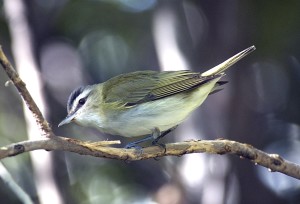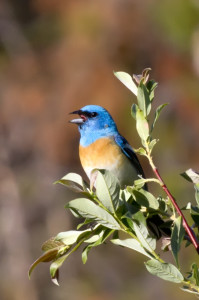Montana Audubon River Initiative
Conserving riparian habitat for birds
As they flow through forest and grassland, Montana’s rivers support an amazing variety of bird species. The unique mix of native cottonwood forests with understories of willow and other shrubs combine to form a rich, but uncommon habitat type critical for many kinds of wildlife. Only about three-percent of Montana’s land area is comprised of streamside (riparian) and wetland habitat, but it is used by over half of all of our wildlife species, including 102 types of breeding birds and 51 migrants.
 Among the many issues affecting Montana rivers is habitat loss, due to the presence of invasive plant species. Two exotic shrubs in particular, have displaced large areas of native vegetation along several rivers; Russian olive and more recently, saltcedar (also known as tamarisk) have begun to establish populations in some stretches of well-known watercourses like the Missouri and Yellowstone. We first need to understand if there has been a net decrease in bird diversity in heavily-infested locations due to the presence of these invasive shrubs. Species potentially affected by changing riparian vegetation include Black-billed Cuckoo, Lazuli Bunting, Red-headed Woodpecker and Ovenbird to name only a few.
Among the many issues affecting Montana rivers is habitat loss, due to the presence of invasive plant species. Two exotic shrubs in particular, have displaced large areas of native vegetation along several rivers; Russian olive and more recently, saltcedar (also known as tamarisk) have begun to establish populations in some stretches of well-known watercourses like the Missouri and Yellowstone. We first need to understand if there has been a net decrease in bird diversity in heavily-infested locations due to the presence of these invasive shrubs. Species potentially affected by changing riparian vegetation include Black-billed Cuckoo, Lazuli Bunting, Red-headed Woodpecker and Ovenbird to name only a few.
Given the great importance of riverside habitat to birds and the potential to make a meaningful conservation impact, we are now launching the Montana Audubon River Initiative: A program to understand and conserve critical riparian bird habitat along Montana’s waterways. During the initial phase we will bring many parties together, including biologists, volunteers, landowners, weed districts and other public entities, to host a symposium on Russian Olive and saltcedar, and discuss what is being done to manage these species. People have intense affection for rivers and the wildlife they support and we expect stakeholder interest in this effort to be significant.

The great rivers of our state are deeply interwoven with our human and natural history. In real ways, it is rivers that tie Montana together; they served as passageways for early exploration, make agriculture possible and are magnets for both wildlife and people. It should be remembered that many of our human communities here were established along the banks of moving water.
A few river initiative highlights:
>In 2021, Black-billed Cuckoo and avian surveys along the Missouri and Madison Rivers are in full swing again this summer after the cancellation of the 2020 field season due to the COVID-19 pandemic.
>As part of our river-initiative work, Montana Audubon hosted a 2017 workshop on Managing salt cedar and Russian olive along Montana Waterways. As a result, the Montana Invasive Species Council launched a new woody species working group focused on coordinating entities working on tamarisk, or salt cedar, and Russian olive management.
>In 2017 we collaborated with Glacier National Park to survey remote sections of fast-moving water in search of the Harlequin Duck, a Montana species of conservation concern, and one of the most challenging species to survey.